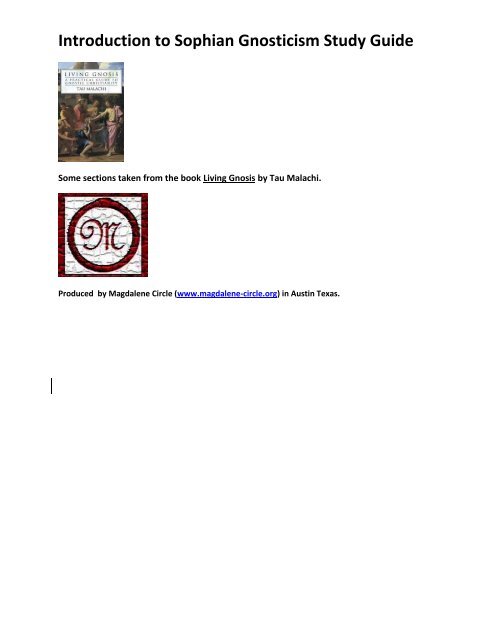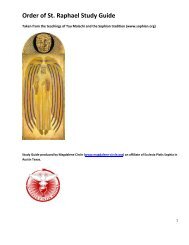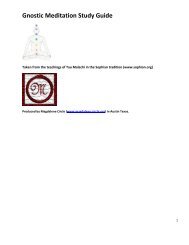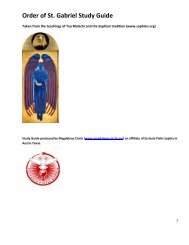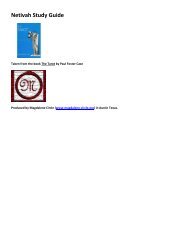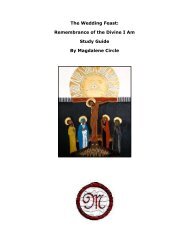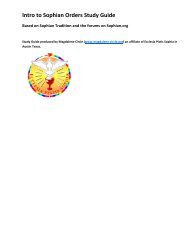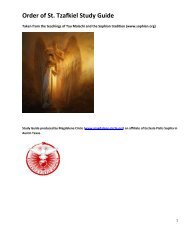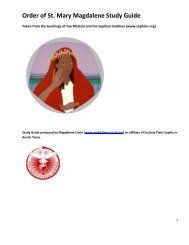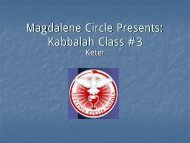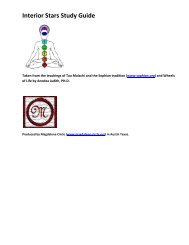Introduction to Sophian Gnosticism Study Guide - Magdalene Circle
Introduction to Sophian Gnosticism Study Guide - Magdalene Circle
Introduction to Sophian Gnosticism Study Guide - Magdalene Circle
- No tags were found...
You also want an ePaper? Increase the reach of your titles
YUMPU automatically turns print PDFs into web optimized ePapers that Google loves.
<strong>Introduction</strong> <strong>to</strong> <strong>Sophian</strong> <strong>Gnosticism</strong> <strong>Study</strong> <strong>Guide</strong>Some sections taken from the book Living Gnosis by Tau Malachi.Produced by <strong>Magdalene</strong> <strong>Circle</strong> (www.magdalene-circle.org) in Austin Texas.
<strong>Sophian</strong> Gnostic Tradition<strong>Introduction</strong>This document is intended <strong>to</strong> serve as an introduction <strong>to</strong> the <strong>Sophian</strong> Gnostic Tradition. It is notintended <strong>to</strong> replace personal study or interaction with a <strong>Sophian</strong> <strong>Study</strong> Group or <strong>Circle</strong>, but will givethe reader an overview of the Tradition and points for further discussion.<strong>Sophian</strong> Tradition and Structure<strong>Sophian</strong> <strong>Gnosticism</strong>Because <strong>Gnosticism</strong> was considered heretical, during the crusades and inquisition anyone who was“proven” <strong>to</strong> be a Gnostic heretic was killed. Most Gnostic traditions went underground and continued<strong>to</strong> operate in secret. Some traditions died out and others continued depending on the ability <strong>to</strong> stayhidden and train initiates.The <strong>Sophian</strong> Tradition’s legends claim the tradition comes directly from Saint Mary <strong>Magdalene</strong>, who isconsidered <strong>to</strong> be the Apostle of the Apostles, as she was the first <strong>to</strong> see the risen Christ. Many of theGnostic texts depict her as a teacher and apostle who was far more advanced than most of hercontemporaries. There is obviously no way <strong>to</strong> prove the tradition came directly from Mary <strong>Magdalene</strong>,as no such records could be maintained. Whether this is his<strong>to</strong>rical fact or part of the Tradition’s mythcycle is unclear, but the teachings of the Tradition closely match what fragments of teachings havebeen found and attributed <strong>to</strong> the <strong>Magdalene</strong>.The Tradition can trace its movement from generation <strong>to</strong> generation from the US back <strong>to</strong> England, <strong>to</strong>France, and <strong>to</strong> Germany. Each generation has a “presiding lineage holder” (spiritual teacher thatguards the tradition and keeps the tradition alive). This presiding lineage holder can be male or femaleand is designated by the previous presiding lineage holder <strong>to</strong> take over upon their death. The currentpresiding lineage holder in the United States is Tau Malachi.Tau MalachiMalachi is a modern Christian mystic and Gnostic whose adventure in the spiritual path began in hisearly youth. At the age of eight he met his beloved Teachers, Tau Elijah ben Miriam and Mother Sarah,who taught and initiated him in<strong>to</strong> the <strong>Sophian</strong> Tradition of Gnostic Christianity, and exposed him <strong>to</strong>diverse lineages of both the Western Mystery Tradition and Eastern Traditions. He became the protégéof Tau Elijah and before his death, in 1978, Tau Elijah imparted <strong>to</strong> Malachi the traditional blessing as his
successor in the <strong>Sophian</strong> lineage. At the age of sixteen, January,1983, Malachi <strong>to</strong>ok up the mantle of the lineage-holder and foundedSophia Fellowship as an expression of the Order (the <strong>Sophian</strong> lineage,outwardly known as “Ordo Sanctus Gnosis”). He has actively servedas a teacher and guide <strong>to</strong> others in the Gnostic Path since that time,holding the recognition of an Elder and Tau in the <strong>Sophian</strong> Tradition.Along with his work in the <strong>Sophian</strong> lineage, Tau Malachi is also a Chevalier in the International Order ofChivalric Companions, a Martinist, and has also received ordination and consecration as anIndependent Apos<strong>to</strong>lic Bishop.Tau Malachi has written several books on <strong>Gnosticism</strong> and the <strong>Sophian</strong> tradition, including: Gospel ofSaint Thomas, Gnosis of the Cosmic Christ, Living Gnosis, Saint Mary <strong>Magdalene</strong>, and Gnostic Healing.<strong>Sophian</strong> Gnostic Structure<strong>Sophian</strong> Gnostic Tradition is broken in<strong>to</strong> two structures: the inner and the outer. The inner tradition iscentered around the presiding lineage holder while the outer tradition is manifested in a church bodycalled Ecclesia Pistis Sophia. The inner group of initiates resides and practices in the same geographicallocation as the presiding lineage holder. The spiritual leaders of this community are either Tau orElder. These designations are based on spiritual attainment and realization of the light power withintheir life (Tau often being the level of the presiding lineage holder). The inner group or fellowship is aclosed organization that can only be joined by being physically in the geographical location of thepresiding lineage holder and being accepted in<strong>to</strong> his/her <strong>Circle</strong>.The outer form of the tradition is called Ecclesia Pistis Sophia (Body of FaithWisdom) and is made up of <strong>Circle</strong>s and study groups throughout the world.Ecclesia Pistis Sophia is roughly the church arm of <strong>Sophian</strong> <strong>Gnosticism</strong> whereinitiates can explore the Tradition with others in their area or through variousdistance attendance methods. Tau Malachi, being the presiding lineageholder, is the presiding Bishop of Ecclesia Pistis Sophia. Each <strong>Circle</strong> or studygroup has a Gnostic Bishop, Priest, Deacon, or Leader who coordinates andorganizes the group. For a group <strong>to</strong> be recognized in Ecclesia Pistis Sophia, the group leader must bemen<strong>to</strong>red in <strong>Sophian</strong> teachings and recognized by Tau Malachi. This is <strong>to</strong> make sure the <strong>Circle</strong>s andstudy groups are continuing the work of the <strong>Sophian</strong> tradition and doing the work that the MotherSpirit has appointed them. Ordination as a Gnostic Priest occurs when a Gnostic Teacher has reachedan appropriate level of spiritual awareness, study, and work; <strong>to</strong> where a Bishop in the traditionbelieves it is time <strong>to</strong> ordain them for the work ahead.In general, meetings of most <strong>Circle</strong>s and study groups in Ecclesia Pistis Sophia are open <strong>to</strong> the public sopeople can learn more about the tradition and its teachings. To become a full member of a <strong>Circle</strong>, anaspirant must be initiated through the three fold rite of initiation and accepted as a Companion by aBishop, Priest, or Deacon through the Rite of Reception.
A Companion is a person who wishes <strong>to</strong> come along-side the Bishop/Priest/Deacon as a spiritual friend<strong>to</strong> learn and serve the tradition. A Companion is a student and a co-worker in the spiritual work of thegroup.Three Fold Rite of InitiationThe Three Fold Rite of Initiation is a beautiful ceremony where the initiate is in<strong>to</strong> anatural setting and initiated in<strong>to</strong> the tradition. The three fold rite consists ofBaptism, Chrism, & Wedding Feast. Baptism is usually performed by immersion inrunning water such as a stream or river <strong>to</strong> represent the death and rebirth in<strong>to</strong> the“true self”; Chrism is anointing with oil <strong>to</strong> symbolize the fiery intelligence of theHoly Spirit coming upon the initiate; and Wedding Feast is a rite with bread andwine that resembles the Orthodox Eucharist, but is used <strong>to</strong> represent the unity allhave with God through the Bridal Chamber.Rite of ReceptionOnce an initiate has undergone the Three Fold Rite of Initiation, they can ask theirteacher <strong>to</strong> receive them as a Companion of the circle. If the teacher agrees, then aRite of Reception is performed where the spiritual teacher accepts the initiate andthey are formally accepted in<strong>to</strong> the body of the <strong>Circle</strong>/<strong>Study</strong> Group.Basic <strong>Sophian</strong> BeliefsThe Name of JesusMuch can be said about the name of Jesus. Jesus is actually the Greek version of his name.In Aramaic, the language he and his disciples spoke, his name would have actually beenYeshua. Many Gnostic traditions use the Aramaic version because it is what he would haveactually been called during his incarnation. Jesus/Yeshua is the same name as Joshua(Yehoshua) from the Old Testament. The difference being that the Hebrew name in the OldTestament was translated as Joshua, and it was translated from Greek in the NewTestament as Jesus.In the New Testament it is said that the name of Yeshua has power and can banish dark andunclean spirits. The question is what is the meaning of this name and why would it have power? Yeshua inHebrew is spelled Yod – Heh – Shin – Vav – Heh. This is very similar <strong>to</strong> the divine name of God, YHWH, which isspelled Yod – Heh – Vav – Heh. In Kabbalah, YHWH is considered the Great Name of God and in the Judaictradition it is so holy that it is not <strong>to</strong> be spoken aloud. So, as we can see above, the name of Yeshua is the sameas YHWH with the addition of the letter Shin in the middle. Calling YHWH a name is actually sort of deceptive. Itis more a designation than a name and is actually a verb instead of a noun. YHWH means “That which was, isand forever shall be”. This can be taken <strong>to</strong> indicate a divine being but also means a force or the Life Power.That being said, the name Yeshua literally translates <strong>to</strong> “YHWH delivers” or “The truth will set you free”. TheShin in Yeshua’s name is very significant because it most often refers <strong>to</strong> the Holy Spirit (or Shekinah). This
Shekinah is the power and presence of God within and beyond creation. This implies that the name Yeshuasignifies an embodiment of this consciousness force and that Gnosis comes by embodying this force.Secret KnowledgeThe willingness <strong>to</strong> seek direct spiritual experience is the foundation of all mystical traditions. This is the heart of<strong>Sophian</strong> <strong>Gnosticism</strong>. The idea of “secret knowledge” is simply because it is impossible <strong>to</strong> tell someone the innerteachings because one has <strong>to</strong> experience them for oneself. In the Gospels (traditional and Gnostic), Yeshuahimself speaks of “inside” and “outside” knowledge. Here is a passage from the Gospel of Matthew:Then the disciples came and asked him, “Why do you speak <strong>to</strong> them in parables?” Heanswered, “To you it has been given <strong>to</strong> know the secrets of the Kingdom of Heaven, but <strong>to</strong>them it has not been given. For <strong>to</strong> those who have, more will be given, and they will have anabundance, but from those who have nothing, even what they have will be taken away. Thereason I speak <strong>to</strong> them in parables is that seeing they do not perceive, and hearing they donot listen, nor do they understand.”Here Yeshua speaks of outsiders and insiders, and he indicates the distinction is that the insider has someexperience of Gnosis. This does not preclude anyone from becoming an insider. Gnosis is not limited by God orman, but by the individual and their desire for spiritual experience.The Living YeshuaThe Gospel of St. Thomas begins with the statement: “These are the secret sayingswhich the living Jesus spoke and which Didymos Thomas Judas wrote down.” It thencontinues <strong>to</strong> say, “And he said, ‘Whoever finds the interpretation of these sayingswill not experience death.’”The name Living Yeshua is common among Christian Gnostics because it denotes theRisen Christ. If one reads all of the Gnostic Gospels, they will find that almost all ofthem claim that their origin is from the Risen Yeshua, implying that the teachings arefrom a spiritual or visionary experience. This also implies a direct and personal experience of the Chris<strong>to</strong>s.The very nature of the Living Yeshua is not an experience rooted in the past. This is an ongoing experience andmakes Gnostic Christianity a living tradition that grows and evolves.TraditionThe word tradition in the English language has come <strong>to</strong> mean something fixed and makes one think of doctrineor creed. This is not the case with Gnostic Christianity. <strong>Sophian</strong> <strong>Gnosticism</strong> is a living tradition that is rooted intransmission of wisdom and enlightenment. Our tradition represents a body of teachings and practices that aidsinitiates in their ability <strong>to</strong> enter in<strong>to</strong> direct and personal gnostic experience.In the tradition, a Priest (outer branch teacher), Bishop (outer branch spiritual leader), Elder (inner branchspiritual leader), or Tau (inner branch head of the Tradition) is an initiate who has acquired Gnosis of the LivingYeshua and who embodies something of Christ consciousness. In fact, all Gnostic initiates <strong>to</strong> the degree thatthey have achieved something of a higher consciousness, embody something of a living presence ofenlightenment.
Obviously, as this living transmission of wisdom or enlightenment passes from one generation <strong>to</strong> another itgrows and evolves <strong>to</strong> assume whatever form is necessary. Even though the tradition as a whole has a commonlanguage and basic teachings, each Gnostic <strong>Circle</strong> is unique <strong>to</strong> the individuals who are part of it.To truly understand a tradition of Gnostic Christianity, one must seek <strong>to</strong> become an insider by seeking direct andpersonal experience of the truth and light.Acquiring GnosisAcquiring gnosis involves a spiritual friendship with a Priest, Bishop, Elder, or Tau of a living Gnostic tradition. Itis possible for wild gnosis <strong>to</strong> occur and for one <strong>to</strong> come <strong>to</strong> enlightenment without a Gnostic <strong>Circle</strong>, but being par<strong>to</strong>f a Gnostic community is much more likely <strong>to</strong> generate the conditions that will bring about this experience.The purpose of a Gnostic teacher and circle are <strong>to</strong> support one’s own spiritual practice and life. The acquisitionof gnosis and progressive self-realization ultimately comes from consistent spiritual practice and the integrationof one’s spirituality in<strong>to</strong> one's daily life.The <strong>Sophian</strong> Tradition teaches diverse forms of spiritual practice and in-depth teachings. These teachings are allbased on Christian Kabbalah.Son of the Human OneWhen <strong>Sophian</strong> Gnostics speak of the Messiah we do so through principles taught through Kabbalah and themysteries of Messiah and Adam Kadmon (the archetypal or primordial human being).It is important <strong>to</strong> keep in mind that the Hebrew word Messiah has the same meaningas the Greek word Chris<strong>to</strong>s (Christ in English). This word literally means “anointedone” and does not include all of the connotations that the church has put on<strong>to</strong> it.The most common term Yeshua uses for himself is the “Son of Man”, not the “Son ofGod”. This signifies him as the “Son of Adam” or the “Son of the Human One”. Thishas deep significance based on the teachings of Kabbalah. When Yeshua speaks ofhimself as the “Son of Adam”, he speaks of himself as embodying something of theideal human being.According <strong>to</strong> Kabbalah, Adam Kadmon is the pure emanation of divine being, specifically a pure emanation ofthe infinite light. Also, Adam Kadmon is the “image and likeness of God” – a person of light existing in the lightcontinuum.Adam Ha-Rishon is the same but the activation of the divine potential within creation – anenlightened human being.This Adam is both male and female in one body and is reflected in the <strong>Sophian</strong> teachings of Lord Yeshua andLady Mary <strong>Magdalene</strong>.In Kabbalah, everything is said <strong>to</strong> come in<strong>to</strong> being through and for Adam Kadmon. He/She is the potential of alllife and at outset exists in an unconscious unity with the light-continuum. The soul of every human being comesfrom the great soul of Adam Kadmon. We are all a unique expression of Adam and united within him. Asindividuals and as a collective, we are Adam Kadmon awakening and coming in<strong>to</strong> being and in this sense we areall sons and daughters of Adam.When Yeshua speaks of himself as the Son of the Human One, he alludes <strong>to</strong> the realization of this truth and thelight within himself. When he makes “I am” statements, such as “I am the way, and the truth, and the light” it is
of this divine truth he speaks. But he does not speak of himself in this manner alone. In the Sermon on theMount in Matthew he says, “You are the light of the world”, which is <strong>to</strong> say, “You are a person of light whocomes from the light-continuum”.Another esoteric teaching on the title Son of the Human One involves Adam & Eve’s children. Their first twosons are Cain & Abel. Cain kills Abel in a fit of rage and in effect, both are lost. Adam & Eve then have anotherson, named Seth. Seth is said <strong>to</strong> be “the image and likeness of Adam”. Cain and Abel represent the sinner andsaint, darkness and light within a human being. Being the image of Adam, Seth is his true son and the unificationof light and darkness – true humanity. So, when Yeshua calls himself the Son of Man he is calling himself Seth.The name Seth is composed of two Hebrew letters, Shin and Tau. These are the last two letters of the Hebrewalphabet and imply completion or fruition, and a state of perfection.The s<strong>to</strong>ry of Cain, Abel, and Seth reflects the process of awakening of the soul of light in us. In the process ofour awakening, at the outset there is a play of spiritual ignorance and we are unaware of our connection <strong>to</strong> thecontinuum of light. Because of this, dualism occurs and there is an illusion of separation. In this process ofindividuation, the soul enters cycles of incarnation. In this cycle, we forget who we truly are and we must labor<strong>to</strong> reintegrate ourselves <strong>to</strong> the person of light who is united with divine being.To recognize and realize the soul of light in us brings about a spontaneous unification with God. In Christian<strong>Gnosticism</strong> it is a state called Christ Consciousness.Soul of the Light-bearerFrom the Gnostic perspective, the purpose of the divine incarnation is the revelation of what we truly are –revelation of the person of light. It is this revelation that helps us <strong>to</strong> see the image of our true self and thusempowering us <strong>to</strong> activate our divine potential. From our point of view, Yeshua does not come <strong>to</strong> redeem usfrom sin but rather <strong>to</strong> redeem us from cosmic ignorance and <strong>to</strong> impart true gnosis.The image and likeness of God is not the physical body, but the soul of light. Thus, a“human being” is any self-aware and intelligent life form, whether resembling whatwe call human or not. According <strong>to</strong> <strong>Sophian</strong> teachings, human beings exist withinmany world-systems in creation. Wherever self-aware and intelligent life-formsevolve, the truth of the soul of light is revealed by way of an incarnation of the lightpresence – an incarnation of the Chris<strong>to</strong>s.Souls that have been Christed or enlightened transmigrate back in<strong>to</strong> incarnation <strong>to</strong> help teach and serve as anexample <strong>to</strong> those who have not yet come <strong>to</strong> realization. While this may sound strange, the same idea appears inmany world wisdom traditions where they speak of Buddhas and avatars. According <strong>to</strong> <strong>Sophian</strong> teachings,Yeshua is among the most significant and influential light-bearers <strong>to</strong> appear on earth. Thus from a Gnosticperspective, what is meant by Christ extends far beyond the name “Christian”.John the BaptistYeshua may have had any number of spiritual teachers. In the <strong>Sophian</strong> teachings, it is said that Yeshua had 3principle spiritual teachers, but that John the Baptist was his true holy Tzaddik (or spiritual teacher). Theconnection between John and Yeshua is said <strong>to</strong> stem from a previous incarnation. As stated in the Gospels, Johnwas the reincarnation of the prophet Elijah. The tradition also teaches that Yeshua was the reincarnation of thesoul of Elisha, the protégé of Elijah.
Birth of a MysticIn <strong>Sophian</strong> teachings, Yeshua is conceived through the sexual union of Joseph & Maryand even though he is a great soul and spiritual prodigy, he is not born Christed. Thes<strong>to</strong>ry of immaculate conception is considered a myth that is meant <strong>to</strong> conveymysteries of the journey <strong>to</strong> Christ consciousness and the fact that Yeshua was bornfree of the karmic ties that most humans bare. Being born in a barn among animalsis quite symbolic also, as it conveys the idea of the bestial soul (Nefesh) beingtransformed through the process of enlightenment and the actualization of the soulof light (Neshamah).The view of Yeshua being conceived in a natural way is common <strong>to</strong> most Christian Gnostic traditions. Thissubject is also covered in several Gnostic Gospels. The term for Holy Spirit in Hebrew, Ruach Ha-Kodesh, like theterm for God’s divine presence and power, Shekinah, is feminine. There is birth and there is rebirth. Thespiritual birth is a sparking of fiery intelligence and a movement of Grace through Mother Sophia. She ispersonified in the Gospels as Mother Mary.Emergence of the Light-Presence and Light-BearerThe baptism and temptation are the fruition of a long spiritual journey begun in Yeshua’s youth. Thisculminated around the age of 30. This represents light-transmission between a Tzaddik and disciple when thedistinction between the two vanishes and there is only the one light-presence.Words like light-transmission, light-presence, and light-continuum can be somewhat curious and undoubtedlyvague. To someone who has experienced these, they are perfectly clear. The words point at it, but it is actuallya spiritual experience. If a person embodies something of this divine presence, it can be transmitted <strong>to</strong> others –a shared experience can be facilitated. The light-transmission between a Tzaddik and a disciple is somewhatakin <strong>to</strong> a candle that is lit, drawing near <strong>to</strong> another candle. When they separate, both are lit, illuminated andilluminating. It is like the Tzaddik is akin <strong>to</strong> a midwife, and the disciple is one who is in labor <strong>to</strong> give birth <strong>to</strong> theChrist self. It is ultimately the disciple who must work out his or her self-realization and pass through the painsof labor <strong>to</strong> enter in<strong>to</strong> the joy of having given birth.After his baptism, Yeshua was driven out in<strong>to</strong> the wilderness <strong>to</strong> be tempted by Satan. There are many esotericteachings on exactly who and what Satan is among the various traditions of Gnostic Christianity. The nameSatan literally means “adversary”. In Judaic tradition the name is Samael, which means the “poison of God”. Onthe most basic and universal level, Gnostic teachings consider Satan, the ego-illusion. This produces the illusionof separation of us from one another and God. This is called the “evil inclination” in Kabbalah. Because of egoillusionwe tend <strong>to</strong> identify ourselves only with the surface consciousness, our mortal name and form, andpersonal his<strong>to</strong>ry. Yet on a deeper level, there is a part of us that exists beyond space-time – the person of light.All of the temptations by Satan are a product of the ego-illusion. The banishing of Satan, thus, represents thedissolution of the ego-illusion and self-grasping.The Second AdamYeshua stands at the center of the Gospel as a holy person who realizes and embodies supernal consciousness.Yet, in the <strong>Sophian</strong> Gospel, he does not stand alone. Others around Yeshua embody the light-presence, more orless. This becomes most obvious in Gnostic Christian traditions, which speak of St. Mary <strong>Magdalene</strong> as co-equaland co-preacher of the Gospel with Yeshua, and which view Mary <strong>Magdalene</strong> as the divine consort and wife ofYeshua - the female embodiment of the Chris<strong>to</strong>s (Christ presence). In the canonized Scriptures there is a hint at
their relationship. Mary <strong>Magdalene</strong> is the first <strong>to</strong> see Yeshua after his resurrection. In the Gnostic Gospels thereare more direct hints at a special relationship between the two.In the <strong>Sophian</strong> tradition there is a rich and extensive oral tradition about St. Mary <strong>Magdalene</strong>. She is viewed asthe female embodiment of the Chris<strong>to</strong>s. In fact this is where the name of the tradition comes from. Yeshua isconsidered Christ the Logos (Greek for embodiment of Word) and Mary is considered Christ the Sophia (Greekfor embodiment of Wisdom).To gain some insight in<strong>to</strong> the importance of both male and female in the <strong>Sophian</strong> tradition, we must go back <strong>to</strong>the teachings in Kabbalah on Adam. A common title given <strong>to</strong> Yeshua is “the Second Adam”. According <strong>to</strong> theaccount given in Genesis, the first Adam (Adam Ha-Rishon) is androgynous. This is how Adam and Eve areseparated out from this initial Adam. Thus, the teaching is that Yeshua and Mary as Logos and Sophia areactually male and female counterparts.The Exile and Redemption of SophiaIn most Gnostic traditions, the purpose of the divine incarnation is not <strong>to</strong> save the world, but instead <strong>to</strong> save thefallen Sophia who is exiled <strong>to</strong> the world. Essentially, divine wisdom is the nature of consciousness, which is thefoundation of creation and in bondage <strong>to</strong> cosmic ignorance. Thus, through the incarnation, Logos enters theworld <strong>to</strong> awaken and redeem Sophia. Therefore, in her redemption the world and all creatures are redeemed.In the <strong>Sophian</strong> tradition, the s<strong>to</strong>ry of St. Mary <strong>Magdalene</strong> reflects this common theme of <strong>Gnosticism</strong>. Her lifes<strong>to</strong>ry is an allegory of the soul that becomes obscured and lost in the material world. This myth cycle is playedout in the Gnostic gospel called Pistis Sophia.The Good News of The BrideIn <strong>Sophian</strong> teachings, every aspect of the s<strong>to</strong>ry of St. Mary <strong>Magdalene</strong> relates directly <strong>to</strong>the relationship of our own consciousness <strong>to</strong> the Living Yeshua. In truth, our soul is abride <strong>to</strong> the light-presence, and in unification with the light presence, we enter in<strong>to</strong>what Gnostics call the Bridal Chamber.We are all more in <strong>to</strong>uch with our soul of light as little children. The truth and light areinnate <strong>to</strong> the human soul, but obscured by the habitual patterns in consciousnessmanifested from previous incarnations. In unenlightened society, we are quicklytrained <strong>to</strong> develop our outer personality that does not reflect the soul of light within us.Because of this we only identify ourselves with the outer self and surface consciousness.In effect, we become lost and out of <strong>to</strong>uch with the soul of light within.Nevertheless, in the s<strong>to</strong>ry of Mary <strong>Magdalene</strong>, we are <strong>to</strong>ld that anyone who consciously recognizes the plight ofthe soul in the world and who consciously opens her- or himself <strong>to</strong> the truth will be received by the lightpresence,and the soul of light will begin <strong>to</strong> shine from within her or him.The image of Lord Yeshua and Lady Mary, according <strong>to</strong> Gnostic Christianity, is the image of our own true selvesas men and women. In the eyes of <strong>Sophian</strong>s, the need for a Christed woman is quite obvious – how can wespeak of the salvation of both men and women without the image of the Christed person in both male andfemale form?The <strong>Sophian</strong> Gospel
Essentially, what we are exploring is the <strong>Sophian</strong> Gospel, which is a weave of oral tradition, Biblical Gospels, andGnostic Gospels. What characterizes the <strong>Sophian</strong> Gospel is the inclusion of St. Mary <strong>Magdalene</strong> in the Christrevelation. Including Lady Mary brings out the hidden Gospel of Sophia interacting with the Gospel of Logos.There is a parallel between the events of the Gospel revolving around Yeshua and the events of the <strong>Magdalene</strong>’slife. The written Gospels serve as a ground of inspiration for the <strong>Sophian</strong> Gospel as s<strong>to</strong>ries are read between thewritten lines. The main focus of the Gnostic Gospels is the metaphysical and spiritual truths <strong>to</strong> which they point.One must keep in mind that the oral tradition is much richer than the written s<strong>to</strong>ries. The <strong>Sophian</strong> Gospel is notmeant <strong>to</strong> be fixed or static, but instead is living and evolving, fluid and flowing – hence inspired by the Spirit.The Union of the Bride and BridegroomThe Holy Spirit descends upon Yeshua during the baptism. At the same time, aprophet appears <strong>to</strong> Mary. Yeshua experiences the temptation by Satan in thewilderness as he struggles <strong>to</strong> integrate the light-presence that has entered in<strong>to</strong>him. While Yeshua is wrestling with Satan, Mary is struggling against sevendemons – both experience an extreme internal conflict. As Yeshua performs hisfirst miracle, Mary re-enters the Holy Land. There is a great mystery in andbehind what is transpiring with Yeshua and Mary, but it is not isolated <strong>to</strong> them.The implication is that this mystery transpires within all of us.As much as Mary and Yeshua are connected, so are we all. This is the key message of the Gospel, whether takenfrom an orthodox or mystical perspective. In an actual mystical experience, the distinction between what isexternal and his<strong>to</strong>rical and what is internal and spiritual vanishes. When one goes in<strong>to</strong> the inner-mostdimensions of consciousness, the lines between past, present, and future blur.We become bound <strong>to</strong> space-time-consciousness through self-identification with name and form, and personalhis<strong>to</strong>ry – a self-identification with the limited and finite being. If we let go of this limited self-identification andgenerate a new self-identification with fully evolved and enlightened being we would be liberated frombondage.This idea is present in the s<strong>to</strong>ries of Lord Yeshua and Lady Mary, who identify with the light-presence thatemerges within their experience. Because we so strongly identify with our name, form, and his<strong>to</strong>ry, theemphasis on the need for both a man and woman embodying Christ consciousness becomes obvious.The Sacred DanceAccording <strong>to</strong> the <strong>Sophian</strong> Gospel, when Yeshua <strong>to</strong>ok Mary in<strong>to</strong> the wilderness, she asked him <strong>to</strong> instruct her.Over the course of five days, he taught and initiated her in<strong>to</strong> the outer, inner, and secret teachings of the Gospeland revealed <strong>to</strong> her the true nature of the divine kingdom – that the kingdom exists within a person <strong>to</strong> thedegree a person can bring forth his or her soul of light.In many intimate and private moments, it is said that Yeshua imparted <strong>to</strong> Mary thewisdom that he shared with no other disciple. Because <strong>Magdalene</strong> received theseteachings, she knew focused questions <strong>to</strong> ask <strong>to</strong> bring out inner and secretteachings in the company of other disciples, so that others might receive greaterwisdom.When Yeshua <strong>to</strong>ok his close disciples aside for teaching, Mary was often there aswell. It is not in the canonized Gospels, but Mary was also present at the
transfiguration. According <strong>to</strong> legend, the male disciples fell unconscious because of the display of fluid realitythat Yeshua presented. Mary, on the other hand, stayed lucid and conscious, receiving the full light transmissionthat Yeshua intended.Mary was the primary teacher of the women disciples, but she also taught and initiated any men who receivedher. As the s<strong>to</strong>ry goes, the night of the transfiguration Mary <strong>to</strong>ok 3 of her closest disciples in<strong>to</strong> a cave and wastransfigured before them. The image of the primordial Eve and Lilith appeared with her.The Mystery of Anointing and CrucifixionIn the <strong>Sophian</strong> Gospel it is Lady Mary who anoints Yeshua with costly perfume as preparation of holy sacrificeand the ultimate revelation of the light presence. St. Mary’s depiction in the <strong>Sophian</strong> Gospel as the one whoanoints Yeshua is important for it is a magical act which makes the body of Yeshua a talisman of the karma ofthe world soul, thus making the redemptive aspect of the crucifixion possible.Their wedding is akin <strong>to</strong> the mystical union of the priest-king and priestess-queen. Among Gnostics theCrucifixion is a very complex discussion. Some Gnostics view the appearance of Yeshua on the cross ascompletely illusionary while others speak of an actual incarnation and death. Often Gnostics are pointing <strong>to</strong>something in between this point of view. This represents the fact that Gnostics seek an inner knowledge andunderstanding of this event. Unlike traditional and fundamentalist traditions, there is no dogma about it.The Bride in the Passion, Crucifixion, and ResurrectionSt. Mary <strong>Magdalene</strong> is present at the Last Supper. With the women disciples, she prepares the room, lights thelamps, and invokes the divine presence and power. When the male disciples accompany Yeshua <strong>to</strong> the garden,Mary and the female disciples hold a vigil of prayer and meditation throughout the night.The cross represents an interesting symbol in <strong>Sophian</strong> tradition. It represents the union of Logos and Sophia –the Bridegroom and the Bride. The vertical axis is Logos and the horizontal is Sophia. <strong>Sophian</strong> Gnostics point <strong>to</strong>a cross of light and spirit instead of one of wood.Although Mary was aware that Yeshua would be resurrected, she still mourned the loss of her husband and love.Unlike the traditional s<strong>to</strong>ries where St. Mary <strong>Magdalene</strong> goes <strong>to</strong> the <strong>to</strong>mb unaware of who Yeshua is, the<strong>Sophian</strong> tradition teaches that she goes with great joy in expectation of his resurrection.In the <strong>Sophian</strong> view, Yeshua is the light and Mary is the prism through which the light is refracted in<strong>to</strong> rays ofrainbow glory. Each ray is a different grade of the light transmission and each apostle receives the rays that heor she is capable of receiving and imparting. Thus there are inner, outer, and secret levels of the lighttransmission.
The Risen Savior and St. Mary <strong>Magdalene</strong>Most of the Gnostic Gospels begin where Orthodox ones end – at the resurrection.Many of the oral traditions speak of St. Mary <strong>Magdalene</strong> as the Risen Savior appears <strong>to</strong>her more than anyone else.The large part of the <strong>Sophian</strong> tradition does not center on the sacred dance betweenLady Mary and Lord Yeshua, but instead focuses on the love-play between the RisenSavior and the Holy Bride. There is a deep dialogue of Christian Kabbalah at its center.We must remember that the discussion in <strong>Gnosticism</strong> of the Risen Savior and HolyBride go much deeper than a discussion of Lord Yeshua and Lady Mary. They arepersonifications of Savior and Bride. Gnostics are always pointing <strong>to</strong> something that is beyond what meets theeye.Conceptions of GodIf you realize how many Gospels there are in Gnostic tradition, you quickly realize how many different views ofGod there are also. Gnostic traditions can have radically different views of God from a very dualistic approach (agood God and a bad God) <strong>to</strong> God as an impersonal force.The <strong>Sophian</strong> Conception of GodIn Kabbalah there are three common terms for God that relate directly <strong>to</strong> our vision.They are Ain, Ain Sof, and Ain Sof Or. Ain means “no-thingness”; Ain Sof means the“infinite”; and Ain Sof Or means “infinite light”.The term Ain in <strong>Sophian</strong> tradition denotes that God is completely beyond our mentalfaculties. This is <strong>to</strong> say that God is neither something nor nothing. One way <strong>to</strong> lookat this is <strong>to</strong> look in<strong>to</strong> our own consciousness and see where thoughts arise. They donot appear <strong>to</strong> have a beginning or an end. They are no-thing. This points <strong>to</strong> the idea that our consciousness isthe same as the nature of God. So, <strong>to</strong> know God, we must know ourselves.We can understand the nature of God by looking at our own self-hood. We experience a distinct sense of self,yet when we look inward and go looking for the self, there is no self <strong>to</strong> find. Yet, when we turn outward the selfseems <strong>to</strong> reappear. Thus we can experience God as both personal and impersonal; as immanent andtranscendent. Basically, <strong>Sophian</strong> teachings constantly remind us that whatever concepts of the ultimate truthwe may have, they are not the ultimate truth itself.God the Father and God the MotherAccording <strong>to</strong> Kabbalah the first human soul, Adam Kadmon is an androgynous being.We are also <strong>to</strong>ld that Adam is created in the image and likeness of God. Thus, we mustassume that God is also an androgynous being. <strong>Sophian</strong>s believe that God is beyond allgender association whatsoever. Yet, Adam was divided in<strong>to</strong> male and female and bothwere said <strong>to</strong> be in the likeness of God. So, we often speak of the male and femaleaspects of consciousness and the male and female aspects of the divine being.If one looks in<strong>to</strong> the word Spirit in both Hebrew and Greek, one will find that in Hebrewit is actually a feminine word and in Greek it is neuter, having no specific genderassociation. This brings the question as <strong>to</strong> why traditional Christian theologians have
decided that the Holy Spirit is male. <strong>Sophian</strong> Gnostics consider the Holy Spirit <strong>to</strong> be feminine and often calls herthe Mother Spirit.<strong>Sophian</strong> tradition does speak of a trinity, but more often of a tetrad consisting of Father, Mother, Son, &Daughter. This is reflected in the divine name Yahweh which consists of the Hebrew letters Yah, Heh, Vav, Heh.The Yah is considered God the Father, the first Heh is God the Mother, the Vav is God the Son, and the secondHeh is God the Daughter (or Bride).The Father in <strong>Sophian</strong> tradition is considered the transcendent form of the divine and is the divine nameYahweh, the force of divine power, while the mother is the imminent aspect of the divine and is the divine nameElohim, the matrix of the life-power in many forms. When we speak of the Father & Mother, we are notspeaking of a God and Goddess, but of masculine and feminine aspects of the One God, which is both Motherand Father.The Bright and Dark Mother and the Earthly MotherBecause the Mother is the immanent aspect of God, she has both dark and light manifestations because she isthe matrix of creation. Every manifestation of being-conscious-force is the Mother. God the Mother is thedivine presence and power we encounter and experience within and behind everything. This is true of thematerial world, inner dimensions, and the spiritual world. The divine mother does not change, but how we viewher does – creating the dark and light aspects.A common invocation of <strong>Sophian</strong>s includes the terms “Heavenly Father and Earthly Mother”. This points <strong>to</strong> thefact that the Mother is the Holy Spirit and is all around us at all times. The Mother is God’s presence that weexperience all around us all the time.Mother MaryIn traditional churches, Mother Mary is seen as the Mother of Christ, but not as God theMother. She is seen in various ways, but mostly as an intercessor between human beingsand God.Mother God.Among Gnostics, the view of Mother Mary is diverse. Some do not speak of her almost atall while others see her as much more. In the <strong>Sophian</strong> tradition she is seen as anotherimage of Christed womanhood. It is felt that she also reached enlightenment, just asYeshua and Mary <strong>Magdalene</strong> did. In our tradition she is seen as a personification ofDemiurgosThere are many different myth cycles among Christian Gnostics. All Gnostic traditions dospeak of the demiurge and archons, but how they see these beings can be quite different.Some dualistic schools believe that the God of the Old Testament is the Demiurge (falsecrea<strong>to</strong>r) and the God of the New Testament is the True God. <strong>Sophian</strong> tradition believes thatDemiurge is a spiritual being of cosmic ignorance. This is any time we see God in our imageinstead of his/her true image. So, Demiurge is seen in many forms. When people commitatrocities or act in ignorance in the name of God, they are actually acting for Demiurgos andnot the one true God. This can be seen in some s<strong>to</strong>ries of the Old Testament, but can also beseen in modern times when someone commits murder in the name of Jesus. In either case, this is a being ofignorance and not the true Light.
Archons in the <strong>Sophian</strong> mythos are beings of admixture. They are the beings of grey instead of light or dark. AnArchon is very much like a human from the standpoint that they have their own agenda and their own reasonfor what they do.The Play of Cosmic ForcesThe process of one becoming many gives way <strong>to</strong> play of cosmic forces in creation. In this play there are divine,admixed, and demonic forces – beings of light, admixture, and darkness. In the tradition, this play of cosmicforces is not external <strong>to</strong> us. We draw <strong>to</strong> us and even create spiritual beings based on our consciousness. Ourstate of mind, intentions, and what we cleave <strong>to</strong> draws these forces <strong>to</strong> us. It is a symbiotic relationship going onall around us. Thus, our path of inner exploration is about trying <strong>to</strong> find our way through this maze of emotionsand desires <strong>to</strong> draw more light <strong>to</strong> ourselves.The Nature of ApocalypseThe word apocalypse actually means revelation. It doesn’t mean big bad end of the world as we have come <strong>to</strong>consider it. For a <strong>Sophian</strong> Gnostic, apocalypse is something that has <strong>to</strong> happen in every person’s experience fortheir path <strong>to</strong> enlightenment. We must have this revelation or apocalypse within our own experience <strong>to</strong> trulygrow and evolve as spiritual beings. Sometimes the apocalypse is difficult and painful aswe find our way through our egoistic desires and find who we really are, but it is not theend of all – just the end of the old self.In addition <strong>to</strong> the personal apocalypse, there is also an idea of a world-wide apocalypsethat will eventually occur. In Kabbalah, this is seen as the end of days when theuniverse gets pulled back in<strong>to</strong> God and all who have become enlightened will reunify with the Divine. TheKabbalistic view is that this is still not the end as God will create again and the whole process starts over.The Coming of ChristThe second coming of Christ is also not the same for a <strong>Sophian</strong> as for a traditional Christian. The first thing <strong>to</strong>remember is that we do not consider Yeshua <strong>to</strong> be the only Christed individual. So, the coming of the Chris<strong>to</strong>scan occur for anyone as they reach enlightenment and supernal consciousness. This second coming is apersonal experience for the individual. There is also a legend in the tradition, that there will be a worldwidesecond coming, when the Chris<strong>to</strong>s as Sophia will manifest in the bodies of several people of various Traditionswho will help lead humanity <strong>to</strong> global enlightenment and liberation.The Old TestamentMany Gnostics have noticed the difference in <strong>to</strong>ne and texture between the Old and New Testaments of theChristian Bible. It has led many <strong>to</strong> believe that it is a different “God” that is spoken of between the two. TheSethian Gnostic tradition (among other dualistic Gnostic schools) attributed the Old Testament <strong>to</strong> the Demiurgeand the New Testament <strong>to</strong> the True God. In the <strong>Sophian</strong> tradition we do not believe that it is God that changesbetween the testaments, but instead the people that have changed. We see the difference as a spiritualevolution of the people as we move from through the Old and New Testaments.When <strong>Sophian</strong> Gnostics look at scriptures they see a progressive light transmission occurring at various levels,each more refined and evolved from the last. They look <strong>to</strong> draw whatever spiritual wisdom they can, leavinganything obsolete behind.
Sacred UnityThe Hebrew word Anoki is used in the Old Testament <strong>to</strong> mean “I Am”. This is used in Exodus 20:2-3 where Godsays, “I am the Lord your God”. This alludes <strong>to</strong> the divine name Eheieh. God uses this divine name <strong>to</strong> describehim/herself <strong>to</strong> Moses at the burning bush with the phrase “Eheieh Asher Eheieh” which means “I am who I am”or “I am that I am” or “I shall be that I shall be”. Anoki also relates <strong>to</strong> the name of Enoch which means“initiate”. All of this points <strong>to</strong> the central unity that the light presence of God is within and behind all creaturesand creation. This relates directly <strong>to</strong> when Yeshua says “I am the way, and the truth, and the life…”. Meaningthe Chris<strong>to</strong>s (the light presence within Yeshua) is this unity within all beings.Going FurtherThe <strong>Sophian</strong> Tradition is a rich and complex set of teachings that cannot be summed up in one publication. Tolearn more visit the <strong>Magdalene</strong> <strong>Circle</strong> web site (www.magdalene-circle.org), the <strong>Sophian</strong> web site(www.sophian.org), and/or check out a <strong>Circle</strong> meeting <strong>to</strong> get first hand experience.


